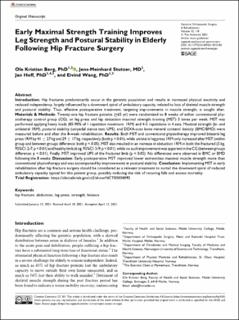| dc.contributor.author | Berg, Ole Kristian | |
| dc.contributor.author | Stutzer, Jens-Meinhard | |
| dc.contributor.author | Hoff, Jan | |
| dc.contributor.author | Wang, Eivind | |
| dc.date.accessioned | 2021-06-11T09:50:49Z | |
| dc.date.available | 2021-06-11T09:50:49Z | |
| dc.date.created | 2021-05-10T10:38:55Z | |
| dc.date.issued | 2021 | |
| dc.identifier.citation | Geriatric Orthopaedic Surgery & Rehabilitation (GOS). 2021, 12, . | en_US |
| dc.identifier.issn | 2151-4585 | |
| dc.identifier.uri | https://hdl.handle.net/11250/2758944 | |
| dc.description.abstract | Introduction: Hip fractures predominantly occur in the geriatric population and results in increased physical inactivity and reduced independency, largely influenced by a downward spiral of ambulatory capacity, related to loss of skeletal muscle strength and postural stability. Thus, effective postoperative treatment, targeting improvements in muscle strength, is sought after. Materials & Methods: Twenty-one hip fracture patients (>65 yr) were randomized to 8 weeks of either conventional physiotherapy control group (CG), or leg press and hip abduction maximal strength training (MST) 3 times per week. MST was performed applying heavy loads (85-90% of 1 repetition maximum; 1RM) and 4-5 repetitions in 4 sets. Maximal strength (bi- and unilateral 1RM), postural stability (unipedal stance test; UPS), and DEXA-scan bone mineral content/ density (BMC/BMD) were measured before and after the 8-week rehabilitation. Results: Both MST and conventional physiotherapy improved bilateral leg press 1RM by 41 ± 27 kg and 29 ± 17 kg, respectively (both p < 0.01), while unilateral leg press 1RM only increased after MST (within group and between groups difference: both p < 0.05). MST also resulted in an increase in abduction 1RM in both the fractured (5 kg, 95%CI: 2-7; p < 0.01) and healthy limb (6 kg, 95%CI: 3-9; p < 0.01), while no such improvement was apparent in the CG (between groups difference: p < 0.01). Finally, MST improved UPS of the fractured limb (p < 0.05). No differences were observed in BMC or BMD following the 8 weeks. Discussion: Early postoperative MST improved lower extremities maximal muscle strength more than conventional physiotherapy and was accompanied by improvements in postural stability. Conclusion: Implementing MST in early rehabilitation after hip fracture surgery should be considered as a relevant treatment to curtail the downward spiral of reduced ambulatory capacity typical for this patient group, possibly reducing the risk of recuring falls and excess mortality. | en_US |
| dc.language.iso | eng | en_US |
| dc.publisher | SAGE Publications Inc. | en_US |
| dc.relation.uri | https://doi.org/10.1177%2F21514593211015103 | |
| dc.rights | Navngivelse 4.0 Internasjonal | * |
| dc.rights.uri | http://creativecommons.org/licenses/by/4.0/deed.no | * |
| dc.title | Early maximal strength training improves leg strength and postural stability in elderly following hip fracture surgery | en_US |
| dc.type | Peer reviewed | en_US |
| dc.type | Journal article | en_US |
| dc.description.version | publishedVersion | en_US |
| dc.source.volume | 12 | en_US |
| dc.source.journal | Geriatric Orthopaedic Surgery & Rehabilitation (GOS) | en_US |
| dc.identifier.doi | 10.1177/21514593211015103 | |
| dc.identifier.cristin | 1909104 | |
| dc.description.localcode | This article is distributed under the terms of the Creative Commons Attribution 4.0 License (https://creativecommons.org/licenses/by/4.0/) which permits any use, reproduction and distribution of the work without further permission provided the original work is attributed as specified on the SAGE and Open Access pages (https://us.sagepub.com/en-us/nam/open-access-at-sage). | en_US |
| cristin.ispublished | true | |
| cristin.fulltext | original | |
| cristin.qualitycode | 1 | |

